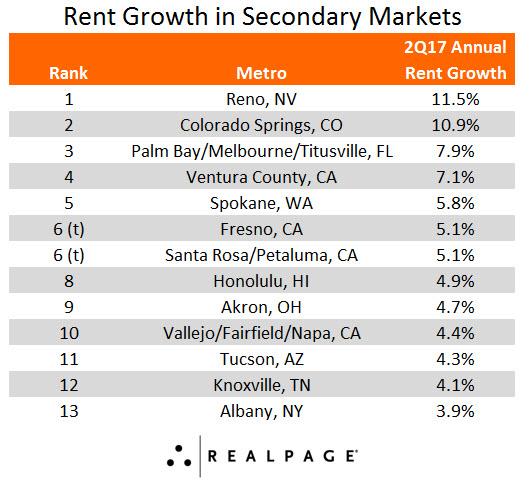Top Secondary Markets for Rent Growth in 2Q

In 2nd quarter 2017, national annual rent growth rose to 3.6%. While the average 3.7% increase of the top 50 U.S. metros drove much of that growth, many secondary markets held their own – and even outperformed their larger counterparts.
Pricing power is generally less in smaller metros, as evidenced by the average 3.0% rent growth generated by the 50 secondary U.S. markets. Still, a handful of top contenders in the secondary arena managed to see rent growth of more than 5.0%. Two of those smaller markets, each situated in the West region, increased rents by more than 10.0%. No large market saw rent growth reach double digits.
Reno and Colorado Springs were by far the top performers among secondary markets, registering annual rent growth of 11.5% and 10.9%, respectively. Reno has seen annual rent growth hit 11.0% in three of the most recent four quarters. Those growth levels are roughly double those seen in late 2015 and early 2016. Operators have benefited from a packed market and limited completions. Meanwhile, the metro has benefited from local efforts to diversify the economic base. Several big-name corporations have landed in Reno in recent years, with announcements of more on the way. That has positioned Reno as a national leader for job creation over much of the past two years.
Colorado Springs also experienced strong rent growth in recent quarters, with annual increases of 8% to 11% since mid-2016. Like Reno, Colorado Springs has seen limited development activity throughout the current cycle, even with job growth sustained at solid levels. This combination of factors has yielded a very tight market, with occupancy at around 97% to 98% since late 2015. Structurally, Colorado Springs boasts strong demand drivers with a heavy presence of major military installations and aerospace and defense employers.

Meanwhile, California’s secondary markets dominated the leaderboard, with Ventura County, Fresno, Santa Rosa/Petaluma and Vallejo/Fairfield/Napa each registering notable rent increases. Ventura County has generally followed the same trajectory as its neighboring large markets in Southern California. The two Northern California markets – Santa Rosa/Petaluma and Vallejo/Fairfield/Napa – have managed to avoid the recent slowdown seen in the Bay Area. Instead, those markets have generally followed performances in Sacramento, suggesting recent momentum is due to economic growth and tight market conditions stemming from a late-cycle recovery. Similarly, Fresno is one of the last markets nationally to enter into a recovery period following the recession.
Further down the leaderboard, Knoxville made an unexpected appearance. Robust Class A and B performances, particularly in submarkets North Knoxville and West Knoxville, lent to the metro’s annual rate change of 4.1% – growth well above the five-year average of 2.5%. Annual absorption in the market has remained elevated since late 2015, when a three-year dip in demand ended.






